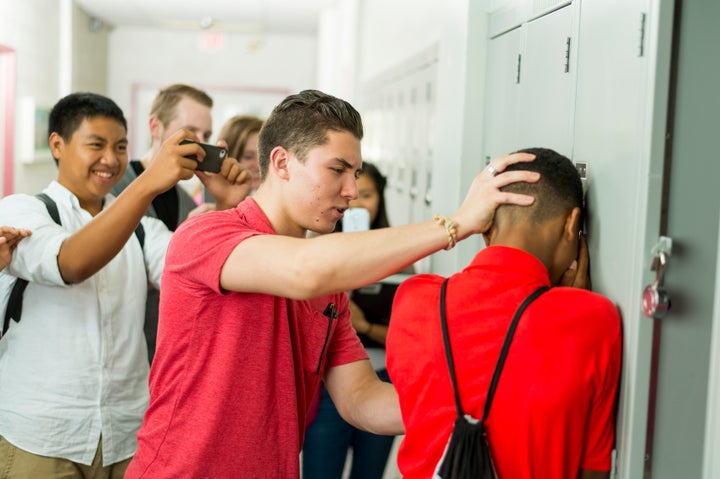
The dry, brown pine needles crunched under my feet as I trudged up the hill above my middle school. Head drooped, eyes always to the ground, I avoided eye contact and the pine cones. But, I hardly ever avoided the gang of bullies waiting for me at the top. The verbal harassment — always “fag,” or “homo” — began before my feet stepped off the sidewalk that marked the end of school property. This was the proverbial “line in the sand” school officials cited to claim there was little they could do to stop the anti-gay bullying I experienced almost every day.
I can still see their leader standing at the top of the hill. Tall and thin, with long, brown, feathered hair, he always dressed in the same clothes: jean jacket, tight blue jeans, and brown, suede, leather boots with fringe. Looking back, it’s bizarre that he ― mirroring the ‘80s gender-bending, hair metal bands so popular in my New Jersey rust-belt town ― bullied me for being gender-atypical years before I understood my sexual orientation.
Surrounding me in a half-circle, the pack of boys would follow me until I ran the last few blocks home. Sometimes, they’d push and punch me or pull at my backpack to make my books fall out. The worst was when they’d trip me, laughing at the “faggot” as I fell to the ground.
This happened day after day, year after year. It was simply a part of life in a school district that failed to protect me, living with a fundamentalist Christian mother and stepfather who, given their beliefs about the “sin of homosexuality,” didn’t know what to do or didn’t want to confront it.
Nearly 30 years later, these experiences still haunt me, and my heart breaks for LGBT youth who continue to be disproportionately victimized by pervasive bullying in America’s schools. In fact, according to a new report released Tuesday by the U.S. National Center for Education Statistics and the Department of Justice, in 2015 lesbian, gay, or bisexual (LGB) students in grades 9 through 12 were nearly twice as likely to be bullied at school and online than those who were heterosexual. Unfortunately, the research summarized in this report did not include transgender youth. But, GLSEN’s National School Climate Survey has found that they are even more likely to be victims of school bullying.
This new government report also shows that bullying begins long before high school, just as it did for me. Approximately 15 percent of third graders reported that they were frequently teased, made fun of, or called names by other students. Fourteen percent were frequently pushed, shoved, slapped, hit, or kicked. Other research has confirmed that LGB middle school students are significantly more likely to experience social and bias-based bullying, including rumors and sexual jokes, as well as physical bullying, such as being pushed, shoved, hit, or threatened or injured with a weapon.
My book, LGBT Youth in America’s Schools, co-authored with Sean Cahill, explains that bullying in elementary and middle school often targets youth who do not conform to stereotypical gender roles, long before they may eventually identify as LGBT.
Pervasive and persistent anti-LGBT bullying has life-threatening consequences. Some LGBT youth who were bullied report higher rates of truancy, lower GPAs, and were less likely to attend college. They were also more likely to experience mental illness, including depression and post-traumatic stress disorder. To find relief, many turned to substance use and unprotected sex, and they attempted suicide at higher rates than their heterosexual peers.
We know what it takes to reduce bullying and its consequences. GSAs, teachers who are out of the closet or straight allies, school curricula, sex education, and nondiscrimination and anti-bullying laws that are LGBT-inclusive, all contribute to lower rates of bullying and better health outcomes for LGBT students. But, these interventions are under attack by the Trump Administration and extremists in Congress and state governments across the nation.
Less than two months in office, the Trump administration rescinded federal guidelines that protected transgender students. At the state level, the Human Rights Campaign (HRC) recently reported that 100 anti-LGBT laws have been introduced in 29 states in just the first three months of 2017. These include a bill passed in Kentucky and signed by Governor Matt Bevin, which allows student groups at colleges, universities, and high schools to discriminate against LGBT students.
Amidst these threats, here are three things you can do:
Join GLSEN UP to advocate for laws and programs that protect LGBT students in elementary through high school, including the Safe Schools Improvement Act.
Pledge to be an #Upstander with the Tyler Clementi Foundation and urge your federal representatives to support the Tyler Clementi Higher Education Anti-Harassment Act of 2017.
Take the lead on your social media and in your faith community to educate and encourage your friends and family to protect LGBT youth from bullying. In addition to this article, here’s a moving video you can share featuring Tyler Clementi’s mother Jane.
Compared to when I was bullied in school, there are more resources and help available to LGBT youth. But until we prevent these wounds from happening in the first place — that contribute to higher rates of HIV, mental illness, and substance use in the LGBT community — we will forever be using band aids to deal with life-long trauma. Ending bullying is a critical place to start.
